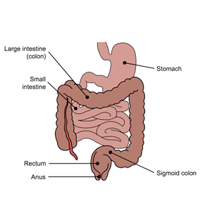| |

Ulcerative Colitis
How
does the digestive system work?
Your
digestive system, or GI tract, is made up of several organs that
together help your body take in food, break it down, distribute
nutrients and get rid of waste.
 The
upper GI tract
includes the mouth, pharynx, oesophagus and stomach.
Food is taken in through the mouth, chewed and swallowed down past the
pharynx, then passed down through the esophagus and into the stomach. The
upper GI tract
includes the mouth, pharynx, oesophagus and stomach.
Food is taken in through the mouth, chewed and swallowed down past the
pharynx, then passed down through the esophagus and into the stomach.
The lower GI tract includes the
large intestine, small intestine and anus. The small
intestine has three parts: the duodenum (the first and shortest
part of the small intestine, where most chemical digestion takes place),
the jejunum (the middle part of the small intestine, largely
responsible for absorption of nutrients), and the ileum (mainly
responsible for absorbing vitamin B12, bile salts and other nutrients).
The large intestine includes the cecum (a pouch that connects the
ileum to the large intestine, which aids in the breakdown of materials
such as cellulose), colon (which removes water and salt and
stores wastes) and rectum (the final part of the large intestine
which serves as a storage area for waste).
The anus is the outer opening of the rectum and is mainly
responsible for getting rid of waste from the body.
Ulcerative colitis only affects the colon (large intestine) and rectum.
The inflammation (swelling) affects the mucosa (lining) of the colon.
In comparison, Crohn’s disease can affect any area of the GI tract, from
the mouth to the anus. The inflammation (swelling) extends deeper into
the lining of the affected area than in ulcerative colitis. There can
also be normal healthy bowel in between patches of diseased bowel in
Crohn’s disease.
Here is a list of the different types of ulcerative colitis and how they
might affect you.
-
 Ulcerative proctitis:
This only affects the rectum and tends to be a milder form of
ulcerative colitis. Ulcerative proctitis:
This only affects the rectum and tends to be a milder form of
ulcerative colitis.
-
Proctosigmoiditis:
Colitis affecting the rectum and the sigmoid
colon (the lower
part of colon located above the rectum). Symptoms include bloody
diarrhoea, cramps
and an urge to use the toilet. There may also be pain on
the
lower left side of the
abdomen.
-
Left-sided colitis:
Continuous inflammation
starting at the rectum and reaching as far as the splenic flexure (a
bend in the colon near the spleen). Symptoms may include weight
loss, loss of appetite, diarrhoea, severe pain on the left side of
the abdomen, and bleeding.
-
Pan-ulcerative (total) colitis:
This affects the entire colon. Symptoms can include diarrhoea,
severe abdominal pain, cramps and extreme weight loss.
In severe cases
In
severe total colitis, possible complications may include severe bleeding
and sudden, severe dilation (widening) of the colon (toxic megacolon),
which can lead to a perforation, or a small hole in the bowel which can
let the contents pass through and cause infection. Although not many
people have these problems, when they do happen they need urgent medical
attention, and may need surgery.
|
|



